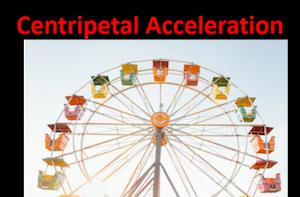Uniform circular motion is defined as the constant-speed motion of an object in a circle. An object in uniform circular motion moves at a constant speed. Despite this, it is accelerating as a result of its change in direction. The acceleration is pointing inwards. For example, any point on a propeller spinning at a constant rate executes a uniform circular motion. Other examples are a watch’s second, minute, and hour hands.

If r is the path’s radius and T is the time it takes to complete a complete circle, then the speed is given by the circumference divided by the period. A similar equation relates acceleration magnitude to speed:
Velocity (v) = 2.Pi.r/T; acceleration (a) = 2.Pi.v/T
These two equations can be combined to give the equation:
acceleration (a) = v2/r (Centripetal acceleration)
Table of Contents
Centripetal Acceleration
Centripetal acceleration is the acceleration produced by a centripetal force on a moving body traversing a circular path. It is denoted by “ac“. It is proportional to the square of the body’s velocity and inversely proportional to the circle’s radius. The direction of this acceleration is radially towards the center of the circle.
Real-Life Examples of Uniform Circular Motion
- The motion of artificial satellites around the earth
- The motion of the blades of the windmills
- Planets Revolving Around the Sun
- The motion of the hands of a clock
- The motion of the moon revolving around the earth
- The circular motion of the Ferris Wheel
Non-Uniform Circular Motion
Non-uniform circular motion is a circular motion in which the body’s speed does not remain constant. The body experiences both normal and tangential acceleration. Some examples of non-uniform circular motion are listed below:
- Anything moving in a circle with non-uniform angular speed
- The motion of a roller coaster
- The motion of a freely falling ball
Uniform Circular Motion Solved Problems
| No. | Question | Uniform Circular Motion Concept | Formula for acceleration | Explanation | Calculations |
| 1 | What is the acceleration of a child on a merry-go-round that is moving at 5 m/s in a circular path with a radius of 3 meters? | Centripetal acceleration | Acceleration directed towards the centre of the circular path, a = v^2/r. | Acceleration directed towards the centre of the circular path, a = v^2/r. | a = (5^2)/3 = 8.33 m/s^2 |
| 2 | What is the acceleration of a car on a roundabout with a radius of 20 meters moving at a constant speed of 10 m/s? | Centripetal acceleration | a = v^2/r | Acceleration directed towards the centre of the circular path, a = 4π^2r/T^2. | a = (10^2)/20 = 5 m/s^2 |
| 3 | What is the acceleration of a spinning top with a radius of 0.5 meters rotating at a constant speed of 2 revolutions per second? | Centripetal acceleration | a = 4π^2r/T^2 | Acceleration directed towards the centre of the circular path, a = 4π^2r/T^2. | a = (4*(π^2)*(0.5))/(2^2) = 0.5 m/s^2 |
Summary
Uniform Circular Motion refers to the motion of a body, object, or particle along a circular path with a constant speed. However, when an object moves in a circle, it constantly changes its direction. In all instances, the object is moving tangent to the circle.
Related Topics
Negative Kinetic Energy
Can Momentum be Negative?
Relativistic Kinetic Energy
How to Find Instantaneous Velocity
Can Velocity be Negative?| Examples
Velocity Time Graph
Frequently Asked Questions
1. Which force brings about uniform circular motion?
The centripetal force is responsible for uniform circular motion. This force is always directed towards the centre of the circular path.
2. What is the difference between centripetal force and centrifugal force?
The direction of each force differs between centrifugal and centripetal forces. Centrifugal force occurs along the circle’s radius, from the centre to the object. The opposite is true for centripetal, which happens along the circle’s radius but from the object inward towards the centre.
3. Uniform circular motion Definition?
Uniform Circular Motion occurs when an object moves in a circular path at a constant speed. Examples. Moon’s Motion around the earth is an example of uniform circular motion.
4. What is a hydropower turbine?
Hydro turbines are equipment used in hydroelectric power plants to transport energy from flowing water to a rotating shaft in order to create electricity. When water is fed into the turbine’s blades, it causes it to revolve or spin.
5. Gamma decay definition?
One type of radioactive decay that a nucleus can experience is gamma decay. When this form of decay occurs, no particles are expelled from the nucleus.
6. light energy definition
Light is a kind of radiation that travels as electromagnetic waves. It may alternatively be represented as a flow of particle-like ‘wave-packets,’ known as photons, travelling at 300,000 kilometres per second.
The term energy of light refers to the energy of photons which is calculated by this equation, E = hf, where E is the energy of the photon in Joules; h is Planck’s constant, which is always 6.63 * 10-34 Joule seconds; and f is the frequency of the light in hertz.
7. Where is thermal diffusivity used?
Thermal diffusivity is a critical concept in the heat transmission process. Thermal diffusivity is the rate at which temperature spreads across a substance. It is a method of measuring heat transfer in a material. It measures the heat transfer from heat to cold material.
8. Work energy formula definition?
According to the work-energy theorem, the work done by the sum of all forces acting on an object equals the change in kinetic energy of the object (or) the net work done on a system equals the change in kinetic energy.
9. What is linear motion in simple words?
In layman’s terms, linear motion is movement along a straight line, whereas nonlinear motion is any movement that is not along a straight line. Linear motion could be uniform or non-uniform. Some examples of linear motion are a bullet fired from a gun, a ball falling from a cliff, and a person walking straight.
10. What are daily life examples of uniform circular motion?
Uniform circular motion is a type of motion in which an object moves along a circular path at a constant speed. Here are some examples of uniform circular motion in daily life:
- The spinning of a washing machine drum during the rinse cycle
- The motion of a merry-go-round at a playground
- The movement of a ceiling fan or a table fan
- The spinning of a CD or a vinyl record on a turntable
- The rotation of a wheel on a bicycle or a car
- The movement of a Ferris wheel at an amusement park
- The orbit of the Earth around the Sun
- The rotation of the Moon around the Earth
- The spinning of a drill bit when drilling a hole
- The motion of a satellite around a planet.
These are just a few examples of uniform circular motion in our daily lives.
More Links
Crest of a Wave| Wave Properties
Flexural Strength- An Overview
Kinematic Viscosity of Water
The Specific Gravity of Water
Can Kinetic Energy be Negative?
Angular displacement
- BCl3 Lewis Structure in four simple steps - November 1, 2023
- PH3 Lewis Structure in four simple steps - October 8, 2023
- PF3 Lewis structure in four simple steps - September 24, 2023



